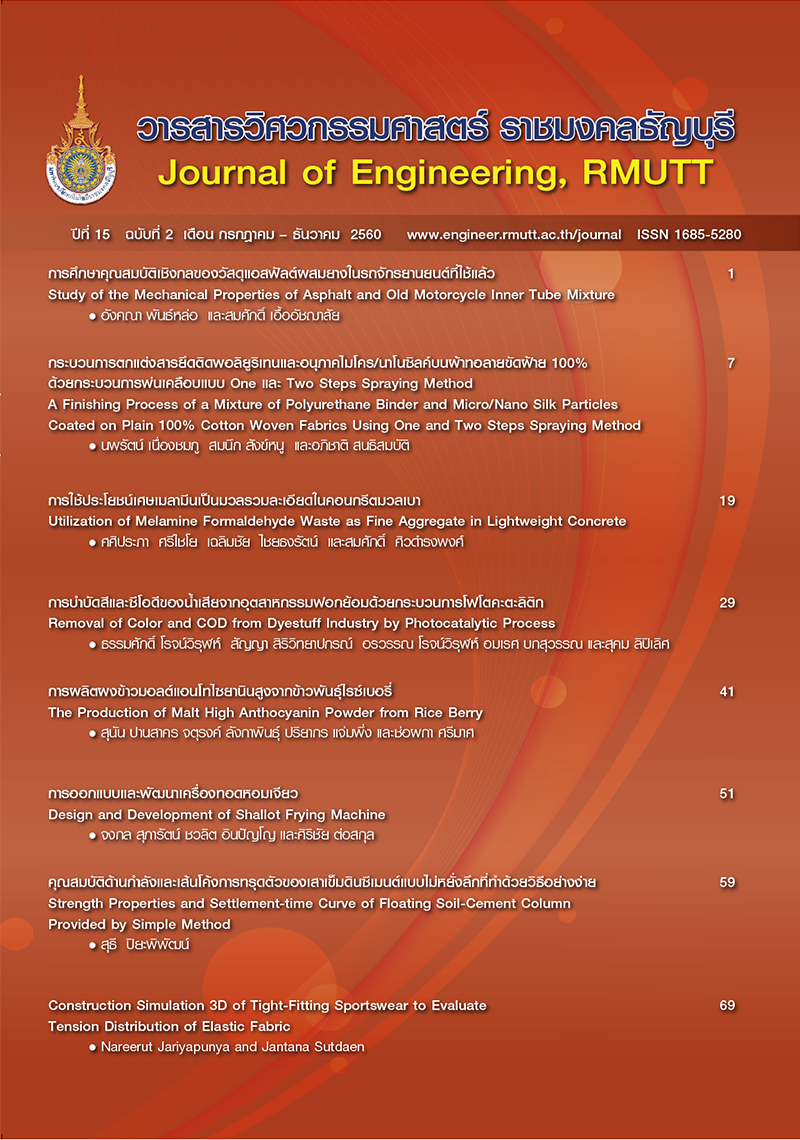Strength Properties and Settlement-time curve of Floating Soil-Cement Column Provided by Simple Method
Main Article Content
Abstract
This research aims to study the strength property in term of unconfined compressive strength (qu) and investigate the settlement-time curve of floating soil-cement column set up by the simple method for using in local community. This simple method is able to conduct with ease and the instruments of soil-cement column making are able to be provided and operated easily by the local people. For the process of proposed method, there are 4 steps as followings 1) Making a hole 2) Mixing soil with water 3) Soil-cement mixing and 4) Soil-cement installation. The effectiveness of the simple method was demonstrated by comparing with the jet grouting method in term of the qu value and dry density (rd) of soil cement column. The testing site was located in Pathumthani, Thailand which the soil layer is a soft clayey deposit. The soil cement columns with the diameter of 0.50 m and length of 4.0 m were constructed by the proposed method and by the jet grouting method. The specimens of testing were collected by using the coring machine. The comparisons of testing results are shown that the qu value of soil cement column by the proposed method is less slightly than that by the jet grouting method. The increasing of curing period increases the qu value and the modulus of elasticity (E50) for both methods. The tendency of qu-gd relationship by the proposed method is the same as that by the jet grouting method. This means the greater gd value, the greater qu value. For the settlement-time curve, the results of both method have the same tendency. The settlement by simple method is higher slightly than that by jet grouting method. Thus, the proposed method can be used to construct the soil-cement column for improving the soft clayey deposit by local people due to easy procedures. The construction tools can also be provided with availability in the local country.
Article Details
The manuscript, information, content, picture and so forth which were published on Frontiers in engineering innovation research has been a copyright of this journal only. There is not allow anyone or any organize to duplicate all content or some document for unethical publication.
References
Kamon, M. (1996), Effective of Grouting and DMM on Big Construction Project in Japan the 1995 Hyogoken-Nambu Earthquake, Grouting and Deep Mixing, The Second International Conference on Ground Improvement Geosystems, Tokyo,Vol.2, pp. 807-823.
Bergado, D.T., Anderson, L.R., Miura, N. and Balasubramanium, A.S. (1996), Lime/Column Stabilization, Soft Ground Improvement in Lowloand and Other Environmental, Asian Institute of Technology, pp. 234-304.
นภดล กรณ์ศิลป์ (2541), ความรู้เบื้องต้นด้านการปรับปรุงคุณภาพดินโดยวิธี Jet Grouting,วิศวกรรมสถานแห่งประเทศไทย, หน้า 1-43.
Chida, S. (1982), Dry Jet Mixing Method – State of the Art on Improvement Methods for Soft Ground, Journal of the Japanese Society of Soil Mechanics and Foundation Engineering, Vol.85, No.2, pp. 69-76.
Lambe, T.W., Mitchael, A.S. and Moh, Z.C. (1957), Improvements of Soil – Cement with Alkali Metal Compounds, Highway Research Board Bulletin. 244, pp. 67-103.
Herzog, A. and Mitchell, J.K. (1963), Reactions Accompanying the Stabilization of Clay with Cement, Highways Research Board Record 36, pp. 146-171.
Chai J.C., Miura N., Kirekawa T. and Hino T. (2009), Settlement Prediction for Soft Ground Improved by Columns. Proceedings of the Institution of Civil Engineers – Ground Improvement 163(2): 109–119.


